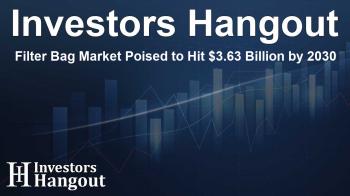Filter Bag Market Poised to Hit $3.63 Billion by 2030

Overview of the Filter Bag Market Growth
The Filter Bag Market is on an upward trajectory, projected to reach USD 3.63 billion by 2030, surging from an estimated USD 2.82 billion in 2025. This growth corresponds to a Compound Annual Growth Rate (CAGR) of 5.2%. The increasing emphasis on industrial emission control, workplace safety, and preserving environmental standards significantly influences this market expansion. In addition, advancements in numerous industries—including cement, power generation, mining, and chemicals—are propelling the demand for efficient and cost-effective filtration solutions.
Drivers of Market Expansion
The market's growth is further bolstered by intensified regulation enforcing air quality standards, as well as global efforts aimed at achieving decarbonization goals. Industries face substantial pressure to limit particulate emissions, maximize energy efficiency, and prolong the lifespan of filtration systems. Consequently, innovations in filter media technologies, such as nanofibers and PTFE membranes, are becoming essential in meeting these demands efficiently.
Technology Innovations in Filtration
Modern baghouse systems are increasingly featuring pulse jet cleaning, IoT-enabled monitoring, and predictive maintenance functions. These enhancements enable businesses to optimize operations and comply with emission standards while reducing operational costs. In developed regions, the upgrade of traditional facilities to incorporate modern filtration systems is commonplace. Meanwhile, emerging economies are experiencing a surge in demand driven by the need to combat urban air pollution and backed by government initiatives promoting environmental responsibility.
Insights into Market Segmentation
A comprehensive report covering various segments, including filter type, filtration fabric, and end-use industries, highlights the multiple potentials within this market. The non-woven segment is anticipated to exhibit the highest growth rate due to its superior performance in dust capture and energy efficiency. Non-woven bags are increasingly favored in critical sectors that require reliable filtration solutions to meet regulatory standards effectively.
Performance of Polypropylene Segment
In terms of market share, the polypropylene segment is expected to be significant by 2030. Its affordability, chemical resistance, and versatility across various applications make it indispensable, particularly in industries exposed to harsh conditions. Polypropylene filter bags are optimal for food processing, pharmaceuticals, and wastewater treatment, showcasing remarkable adaptability to diverse industrial challenges.
Regional Dynamics Influencing Market Trends
Geographically, the Asia-Pacific region is projected to dominate the Filter Bag Market, driven by rapid industrialization and the implementation of strict environmental regulations across major economies like China and India. The increasing activity in the cement and power generation sectors drives substantial demand for filtration solutions that meet emission control requirements.
Adaptation to Global Changes
With the growing focus on sustainability, the filter bag industry must evolve. New technologies emphasize filtration efficiency while adhering to environmental standards. The integration of innovations into traditional systems represents a shift towards sustainable practices in manufacturing, thereby aligning with global sustainability frameworks.
Expanding Market Opportunities
As sectors such as cement, mining, and chemicals continue to expand, the demand for advanced filter technologies capable of providing high levels of efficiency will only increase. Innovative design and materials will further distinguish filter bags as essential components in environmental compliance across industries globally. With this trajectory, the filter bag market is not just about growth in numbers, but about cultivating a sustainable future initiated by innovative filtration solutions.
Frequently Asked Questions
What is the projected growth of the Filter Bag Market?
The Filter Bag Market is projected to reach USD 3.63 billion by 2030, growing at a 5.2% CAGR.
What sectors are driving the demand for filter bags?
Sectors driving demand include cement, power generation, mining, and chemicals, primarily due to regulatory needs for emission control and industrial efficiency.
Why is the non-woven segment important?
Non-woven filter bags offer superior dust-holding capacity, energy efficiency, and longer service life, making them crucial for high-performance filtration.
How does polypropylene rank in the market?
Polypropylene is expected to hold the second-largest market share in 2030, valued for its chemical resistance and versatility in various industrial applications.
Which region leads the Filter Bag Market?
The Asia-Pacific region currently leads the market, fueled by rapid industrialization and stringent environmental regulations in countries like China and India.
About The Author
Contact Hannah Lewis privately here. Or send an email with ATTN: Hannah Lewis as the subject to contact@investorshangout.com.
About Investors Hangout
Investors Hangout is a leading online stock forum for financial discussion and learning, offering a wide range of free tools and resources. It draws in traders of all levels, who exchange market knowledge, investigate trading tactics, and keep an eye on industry developments in real time. Featuring financial articles, stock message boards, quotes, charts, company profiles, and live news updates. Through cooperative learning and a wealth of informational resources, it helps users from novices creating their first portfolios to experts honing their techniques. Join Investors Hangout today: https://investorshangout.com/
The content of this article is based on factual, publicly available information and does not represent legal, financial, or investment advice. Investors Hangout does not offer financial advice, and the author is not a licensed financial advisor. Consult a qualified advisor before making any financial or investment decisions based on this article. This article should not be considered advice to purchase, sell, or hold any securities or other investments. If any of the material provided here is inaccurate, please contact us for corrections.

